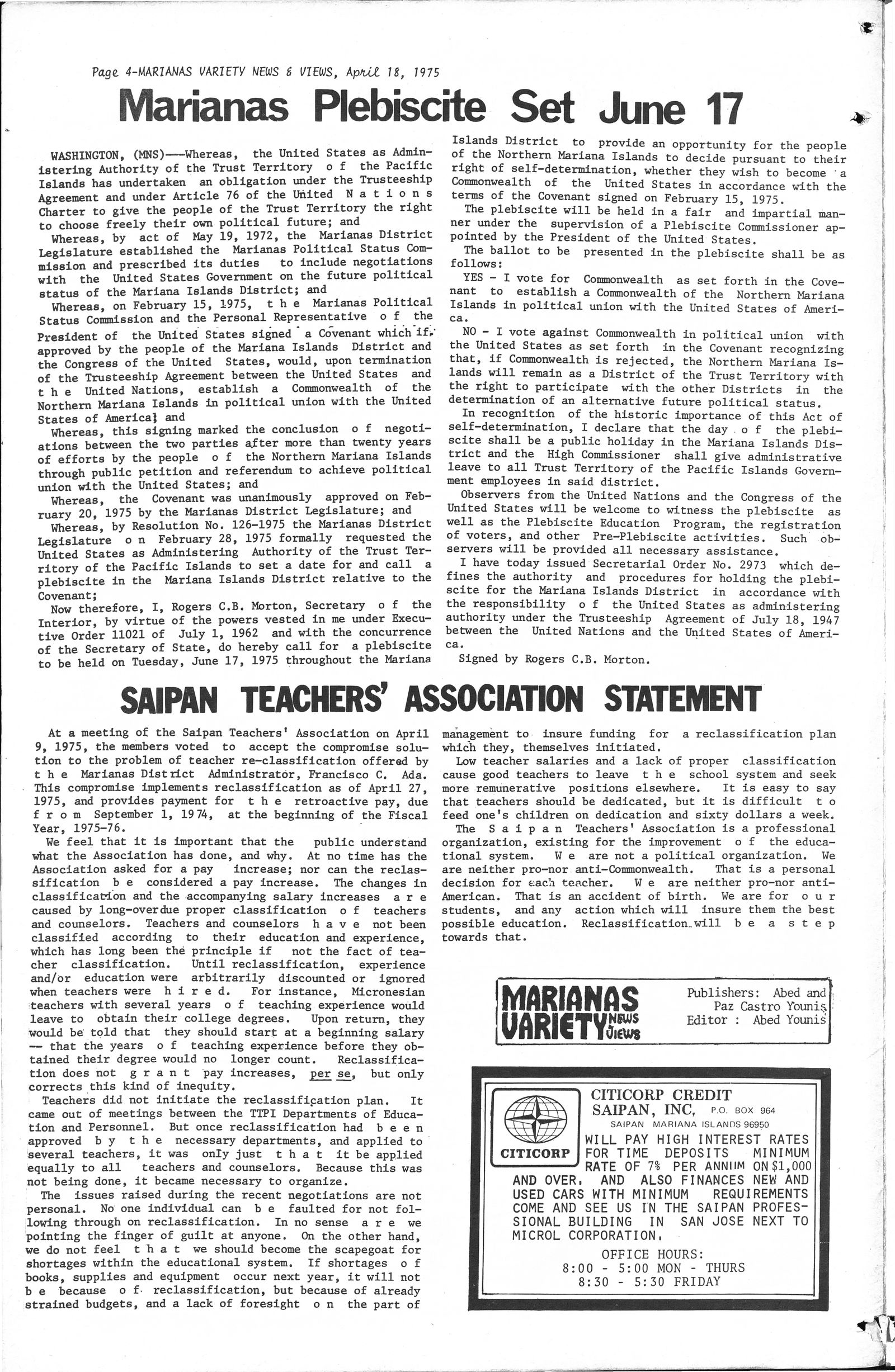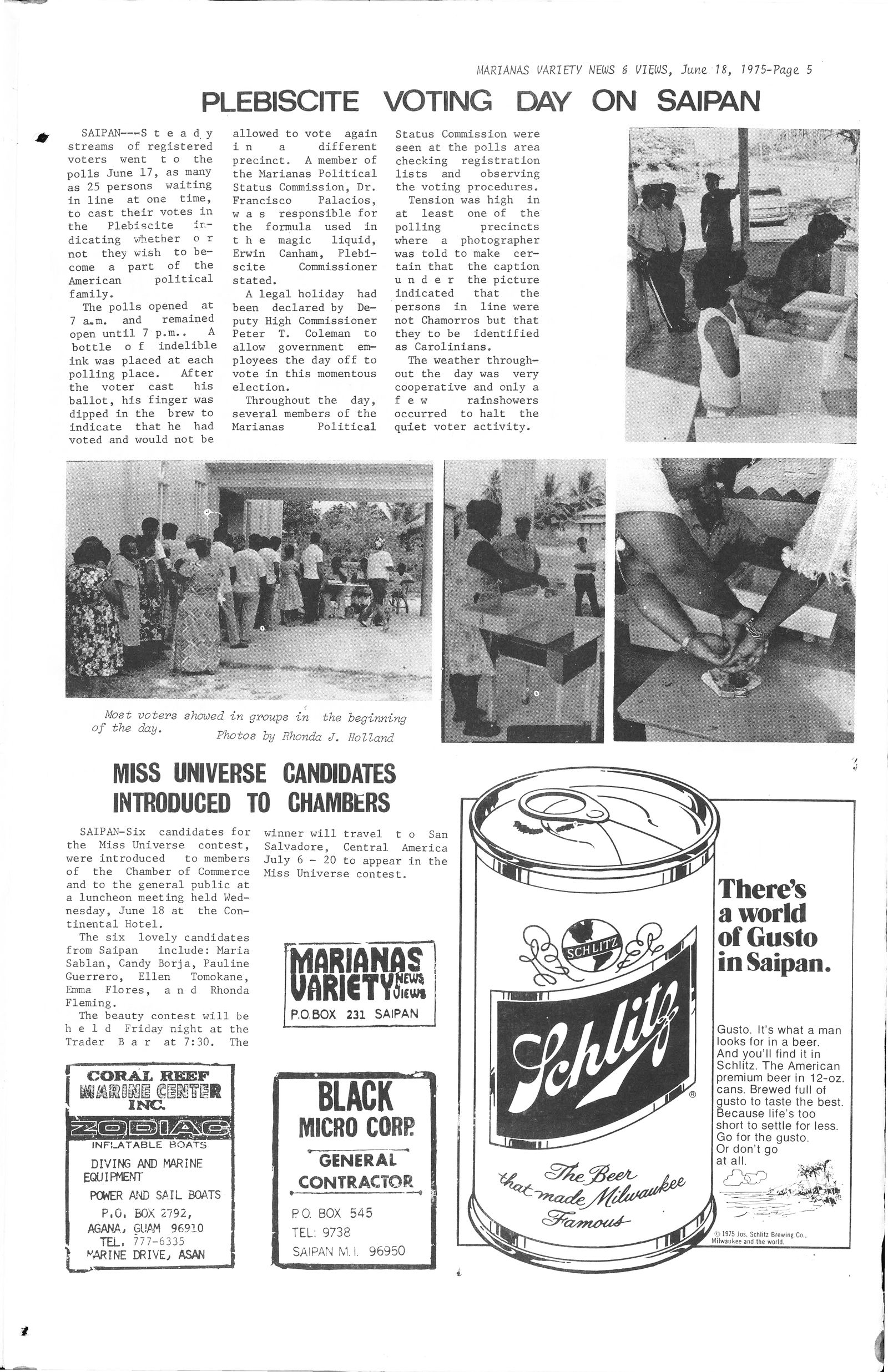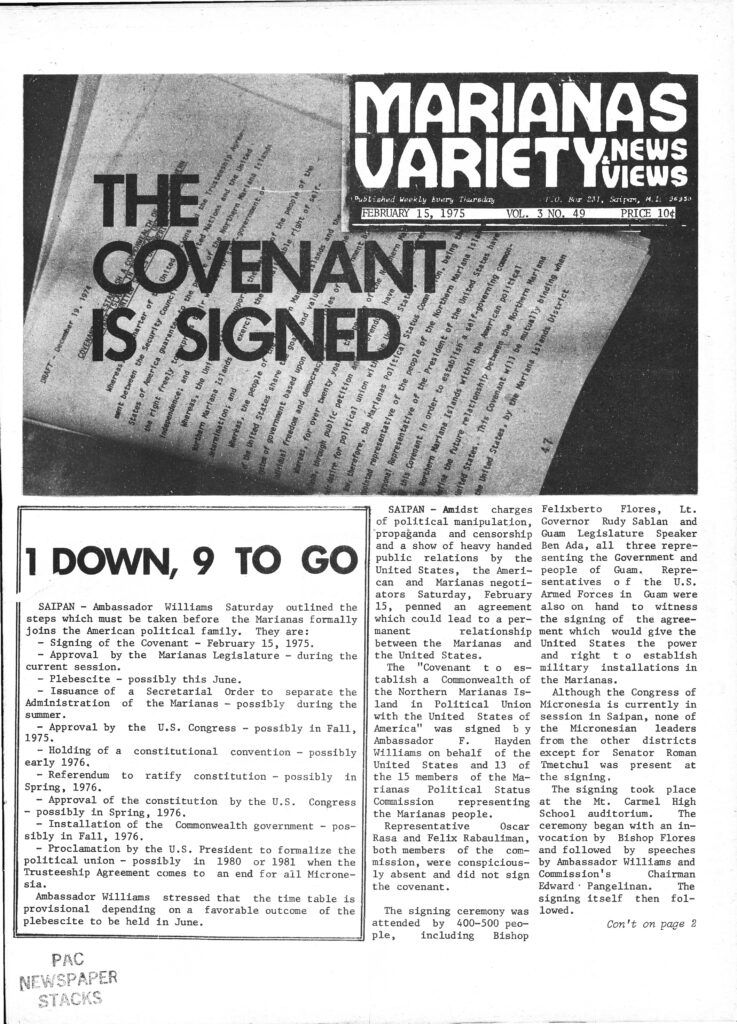<strong>GRAND OPENING </strong>Abed Younis is all smiles during a ribbon cutting ceremony for the grand opening of Younis Art Studio office in Chalan Kanoa in 1972.

February 15, 1975
HE only planned on staying only for a few days; he ended up staying for good and taking up cudgels for causes important to the local community.
In the early 1970s, Abed Younis and his newspaper, Marianas Variety, had been instrumental in getting more people engaged in the political process that would define the islands’ future.
In an interview with Howard Willens and Deanne Siemer on Feb. 11, 1997, Abed talked about the political developments in the Northern Marianas in the 1970s, how he ended up coming to Saipan, and how he was convinced to take over the operation of a fledgling newspaper.
Originally from Ara Village, near Haifa City, in Israel, Abed wanted to explore where his talents could take him. A graduate of Bet Salel Academy of Arts, the enterprising Abed had decided early on to set up his very own shop until the National Television Station lured him away from his atelier.
He was selected not only for his graphic arts background, but also on account of fluency in both Hebrew and Arabic. “I write in both, I design in both, I compose in both. And that is my specialty,” he told Willens and Siemer.
In fact, Abed was trilingual: he spoke Arabic, Hebrew, and English.
<p class=”p1″><span class=”s1″><em>They all intended to burn the Trust Territory. And they did, he said. Even the Trust Territory Code, they kicked it down and they burned it.</em></span>

February 21, 1975

April 18, 1975
After the Arab-Israeli War of 1967, Abed saw an opportunity for self-development. As he was doing animation and children’s programs for Israel TV, Abed took interest in how Japanese culture impacts designs and programs for television. A cultural scholarship offer led him to Japan in 1970.
For a year, he immersed himself in Japanese culture, visited universities and met with professors of graphic arts and animation and learned as much as he could. As his time in Japan was winding down, he was offered a job; however, this required a change in visa. While doing so, he met someone in Japan who encouraged him to visit Guam where he stayed in Merizo for a couple of months. Just as his visa was expiring, he had to leave and found himself on the last flight out to Saipan.
On Saipan, Abed’s stay was initially transitory; but he ended up staying for the long haul. He was encouraged to set up his atelier in Susupe he called Younis Art Studio. Soon, he began doing artwork for Marianas Star, a newsletter published by Gene Peters and Mike Malone. Financial constraints led the duo to throw in the towel and asked Abed to take over. And so he did. Marianas Star became Marianas Variety and its maiden issue came out on March 16, 1972, on a Friday.
In his interview with Siemer and Willens, Abed talked about Variety’s humble beginnings and how he staved off competition from Oscar Rasa’s Free Press and later, Commonwealth Examiner, PDN’s Dateline, and Vic Pangelinan’s Gazette.
When he took over the operation of the newspaper, Abed had envisioned the paper to focus solely on local affairs. What an impeccable timing it was for him to do so. When Abed came to Saipan, the situation was rife for a major political change: the Marianas Political Status Negotiations.
Already in the thick of things in his studio, Abed would find the time to do reporting. He would sit down in legislative sessions undeterred by the proceedings done in Chamorro. He managed by talking to people, getting their sentiments and perspectives of the issues.

Abed Younis is shown in this photo mingling with Jose “Joeten” Tenorio, Herman “Pan” Guerrero, and former Governor Lorenzo “Larry” Guerrero.
Running the newspaper business put Abed in a bind between opposing Territorial and Popular parties. There was a time when he earned the ire of Eddie Pangelinan over an editorial cartoon Abed himself drew. The Popular Party had been acutely critical of the newspaper.
Abed told Willens that the Territorial Party, composed mostly of business-oriented members, had been more engaging compared to the more conservative Popular Party.
“As I said, they were very, very conservative and they did not show an interest in [getting coverage in] the newspaper. They didn’t even want names in the newspaper. They used to be very, very much critical of the newspaper,” he told Willens.
In 1972-1973, Abed believed the people were not ready to make an informed decision about leaving the Trust Territory. “They did not have the opportunity to learn of other political statuses, of other options, of the history of other islands or other nations and so on.” They wanted to get out from under the Trust Territory.
Proof of their displeasure with the Trust Territory were the demonstrations by the local community. “Most of the Popular Party leadership was involved in demonstrations against the Trust Territory building and the Trust Territory Code. I took pictures that night they burned it and I published them.”
Abed, who was taking snapshots of the act of burning was thrown down the stairs.

February 20, 1976

June 18, 1975
The march to the Trust Territory headquarters on Capital Hill was led by the Popular Party leaders Herman Guerrero, Eddie Pangelinan, Herman Palacios, among others. “They all intended to burn the Trust Territory.” And they did, he said. Even the Trust Territory Code, “they kicked it down and they burned it.”
Although the negotiations on the political status had been behind closed doors, Variety sought information wherever it could find them. “As a newspaper, we have to go where there are sources who can give us information. We reported what exactly happened, like what subjects were being negotiated about. Sometimes we would get some copies of documents of discussions or proposals or ideas. We tried our best to get as much information as possible.”
Abed would succeed in getting information from the local side; however, he wasn’t as fortunate to get an interview with the U.S. negotiating team.
After the conclusion of the second session of the negotiations in 1973, Variety was able to get hold of copies of the position papers presented by the commission to the District Legislature and published them. For Abed, this aided public education about the entire process. He even managed to get an interview with three commissioners, Dr. Palacios, Jose C. Tenorio (Joeten), and Felix Rabauliman, who commented that the negotiations had been going too fast, that the “U.S. was better prepared than the Commission.”
Abed said, neither the community nor the Commission was “not fully aware, not fully prepared as to what they wanted or what they expected to have.”
As to the Carolinian community, Abed found them to be cohesive and rallied behind the Territorial Party.
Meanwhile, as Abed focused his reporting on Saipan, he didn’t have reporters on the ground on Tinian and Rota to get the pulse of the communities there. He, however, relied on several people from these islands to relay their concerns and perspectives.
<p class=”p1″><span class=”s1″><em>Abed, who was taking snapshots of the act of burning, was thrown down the stairs.</em></span>
Moreover, Pacific Daily News published a report that the United States had been eyeing the entire island of Tinian for a military base. This had sent shock waves to the community that was opposed to giving away too much land.
U.S. Congressman Phillip Burton of California helped ease the tension. He listened to the local leaders with whom he developed rapport.
Just as status negotiations were moving forward, meanwhile, the other districts had hoped Micronesia would remain intractably unified.

September 26, 1975
Abed himself held the view that the Micronesians should stay together and was disappointed seeing Micronesia breaking up. Chuuk tried to negotiate with the Russians. Then Marshalls and Palau decided to go their own way.
When the Covenant was approved and the plebiscite was set, there were concerns about how the ballot was worded: the binary choice they found restrictive, leaving no door open to renegotiate.
When the draft of the Covenant was made available to the public, more and more people threw their support behind it. Even those previously campaigning against it switched sides.
Abed underscored how the leaders proved crucial to the entire process.
As the dwindling opposition complained over little time to study the document, more people deferred to the local leaders for direction.
Majority in the legislature were for the Covenant except for Larry Guerrero who raised some concerns.
The Carolinian community, on the one hand, had resolved to go against the signing of the Covenant.
In the wake of the Covenant’s approval, uncertainty loomed over their representation, as pointed out by Plebiscite Commissioner Edwin Canham. There was apprehension that neither one of them would be elected delegate to the constitutional convention considering how they voted in the plebiscite.
Ultimately, the Carolinians did get the representation and guarantees in the CNMI constitution that their voices would be heard.
In Abed’s view, the Constitution did resolve a lot of issues, including land alienation and who gets to be recognized as persons of Northern Marianas descent.
When asked by Siemer if it made any difference for the local community to see their constitution translated into their language, Abed believed it brought them pride seeing it written in Chamorro and Carolinian.
More than 50 years ago, Abed left his home in Israel an artist and he passed on in the CNMI as a revered publisher of the longest running locally owned newspaper in Micronesia that chronicled the ebb and flow of Northern Marianas history.

January 10, 1978

About the Author
Alexie Zotomayor served as a reporter and Features editor from Dec 2004 to Feb 2007; and Associate editor from Feb 2011 to Feb 2016. As a reporter, she covered business, culture, and military beats and devoted enormous effort at covering the pension fund crisis, including the Betty Johnson case in federal court that resulted in a settlement agreement for the retirees. She was also proud and honored to have served as member of the planning committee for the 70th Anniversary of the Battle of Saipan/Tinian and as director of PR for Stellar’s Miss Teen. Moreover, she’s thankful to the Variety for the wealth of experience in community journalism the paper has afforded her.












